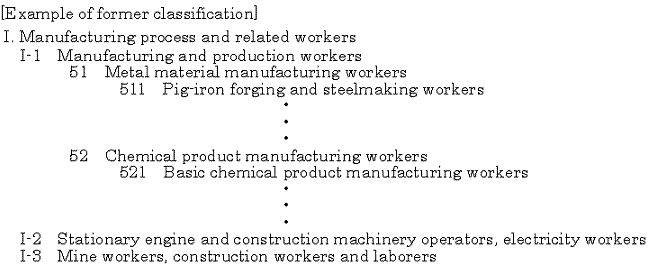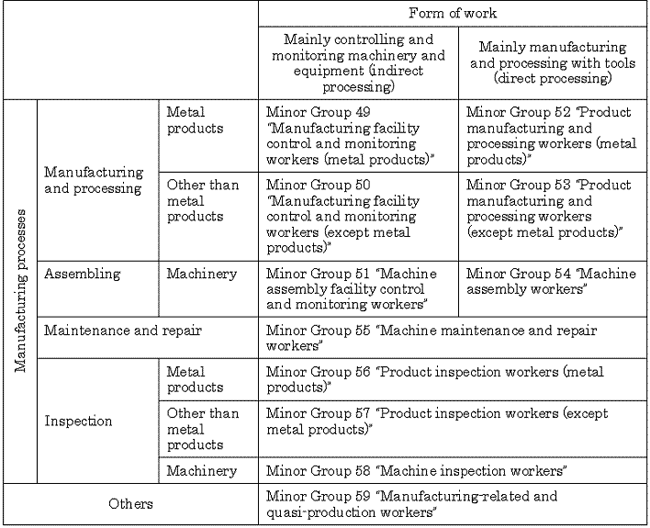Official statistics must be produced based on certain statistical standards in order to ensure uniformity and comprehensiveness of official statistics and to improve their usage. As one form of such statistical standards, the Japan Standard Occupational Classification has been established by classifying occupations according to the similarities between jobs undertaken by individuals and arranging them systematically, in order to express the official statistics for each individual occupation.
The origins of the Japan Standard Occupational Classification can be traced to the Occupational Classification used in the 1st Population Census, which was conducted in 1920.
This Occupational Classification was closer to an industrial classification in today's terms, with the addition of some occupational details. At the time, there was no clear distinction between the concepts of occupational and industrial classifications, the latter merely being conducted under the name of the former. The distinction between occupational and industrial classifications was first made in the 3rd Population Census in 1930. Then, from the 5th Population Census in 1940 onwards, the occupational classification used in the Census was prepared separately from the industrial classification. In the 2nd Population Census in 1925 and the 4th Population Census in 1935, meanwhile, there were no data specific to different occupations.
The impetus for the Occupational Classification to be established in its present form was provided by the World Census proposed by the United Nations in 1950. Japan took part in the Census, and, at the suggestion of the occupying forces (GHQ), a Central Planning Commission was set up within the Cabinet's Statistics Commission in 1950. Research on the various classifications was now promoted as a basic operation in the Census execution plan. For this, along with the various special working groups, an Occupational Classification Special Working Group consisting of a committee, a steering group and a sub-committee was set up.
This Working Group was responsible for preparing the Occupational Classification for the Population Census in September 1950, and then continued to prepare standard classifications. For this, a Technical Committee on Standard Occupational Classification was newly appointed to pursue research.
Following a reform of administrative organs, the Statistics Commission's Occupational Classification Expert Working Group became the Occupational Classification Expert Working Group of the Statistical Standards Department in the Administrative Management Agency from August 1952, though its organizational setup remained the same. In March 1953, a draft proposal for the Japan Standard Occupational Classification was published. This proposal was later re-published in March 1957.
Meanwhile, as part of the aforementioned reform of administrative organs, the Statistics Council was set up as a consultative body to the Director-General of the Administrative Management Agency in August 1952. At the 1st Meeting of the Statistics Council in September of that year, consultation was made on establishing standards for occupational classification used in statistical surveys (Consultation No.2: On the Establishment of Standards for Occupational Classification Used in Statistical Surveys), as well as on the establishment of standards for industrial classification, commodity classification, regional classification and buildings classification.
In response to this, an Occupational Classification Expert Working Group was set up within the Statistics Council in November of the same year, and started to deliberate on the establishment of the Japan Standard Occupational Classification.
After this, the Occupational Classification for the Population Census was created by the Statistics Bureau of the Prime Minister's Office in 1955. In 1958, the International Labour Organization (ILO) established its International Standard Classification of Occupations (ISCO), and deliberations on the Japan Standard Occupational Classification also took such experience and research into account.
Based on this background, a report on the establishment of the Japan Standard Occupational Classification was made by the 90th Meeting of the Statistics Council in March 1960, and in response to this, the Administrative Management Agency established the Japan Standard Occupational Classification in the same month.
Once the Japan Standard Occupational Classification had been established, considerable changes came to be observed in occupations as a result of shifts in socio-economic trends, causing a divergence from reality when applying the standard classification. Moreover, in 1968 the International Labour Organization (ILO) revised its International Standard Classification of Occupations (ISCO) (a draft revision was adopted at the 11th International Conference of Labour Statisticians (ICLS) in October 1966, and approved at the 168th General Assembly in February-March 1967). Therefore, a revision was planned, and consultation on revising the Japan Standard Occupational Classification was made at the 188th meeting of the Statistics Council in May 1968.
A report to this consultation was made at the 209th meeting of the Statistics Council in February 1970, and in response to this, the Administrative Management Agency carried out the 1st revision of the Japan Standard Occupational Classification in March of the same year.
Following this, the 2nd revision was made in December 1979, the 3rd revision in 1986, and finally the 4th revision in December 1997, to keep step with changes in occupational structure accompanying shifts in socio-economic trends.
The former Japan Standard Occupational Classification was not set up based on law or made public through a public notice. At the 166th Session of the Diet held in May 2007, the new Statistics Act (Act No. 53 of 2007; hereinafter the "New Act") approved for the purpose of promoting systematic and efficient development of official statistics and ensuring the usefulness thereof, along with the establishment of the concept of "statistical standards"-technical standards for ensuring uniformity and comprehensiveness in producing official statistics. The statistical standards are to be established by the Minister for Internal Affairs and Communications based on the New Act as a generic name of what serves as standards in producing official statistics. Also under the New Act which provides for the establishment of the Statistics Commission, the former Statistics Council has been reorganized into the Statistics Commission.
Against the background of the New Act having approved the Ministry of Internal Affairs and Communications worked out a draft of the Japan Standard Occupational Classification (representing the fifth revision of its original) based on prevailing contents in December 1997, and consult with the Statistics Commission about newly establishing the draft as statistical standard in April 2009, which was reported back in August of the same year. In response to this action, the Ministry of Internal Affairs and Communications established the Japan Standard Occupational Classification as statistical standard and publicly notified it in December of the same year.
In revising the classification table, the following standpoints were taken into consideration:
Of the three items above, (2) and (3) are the standpoints of revising the entire fields, and have been considered in revisions made in the past.
In making revisions at this time, the items have been set up in consideration of "(1) Standpoint of independence from the industrial classification or commodity classification" with regard to the classification of persons and engineers engaged in manufacturing process work.
In the former classification, occupations have been set up for each product created as a result of industrial or manufacturing activity in which the relevant individual is engaged. This is due to the fact that the "Merkmal" of the segment of occupations was mainly considered to be the content of technologies and knowledge required to develop and manufacture industries and products, and the segments of industries and products were considered to correspond to the segment of occupations. However, along with industrial evolution, technologies became more advanced and specialized, and manufacturing processes became more complicated and divided by the types of jobs, with even the same product requiring segmentalized technical fields, and the manufacturing process being specialized into multiple steps. As a result, the homogeneity of individual occupations became lost with focus on the standpoint regarding technologies and knowledge needed to manufacture products (considered the "Merkmal" of the segment of occupations until then); therefore, a classification system based on a new standpoint had to be set up
In the following section, the major points of revisions in the classification table as of December 1997 (former classification) will be explained with the concrete contents of revisions made at this time:

In the revision made at this time, from the standpoint of making the occupational classification independent from the industrial or commodity classification, the four parts of "Manufacturing and processing," "Assembling," "Maintenance and repair" and "Inspection" that are considered common parts from a cross-sectional standpoint have been separated from the manufacturing processes for various types of products.
In view of the forms of work, the former classification has also been separated into the "Work of operating automated manufacturing facilities including the monitoring of operational status and adjusting the operating conditions of mainly automated devices, plants and other facilities" and the "Work of directly manufacturing or processing products using tools, machinery and other equipment."
Also, the "Product which is the object of industry or work engaged in" (i.e., Minor and Unit Groups in the former classification) has been made a Unit Group, and these groups have been sorted by each manufacturing process, product group and form of work, and classified and set up as the new Minor Groups shown below.
